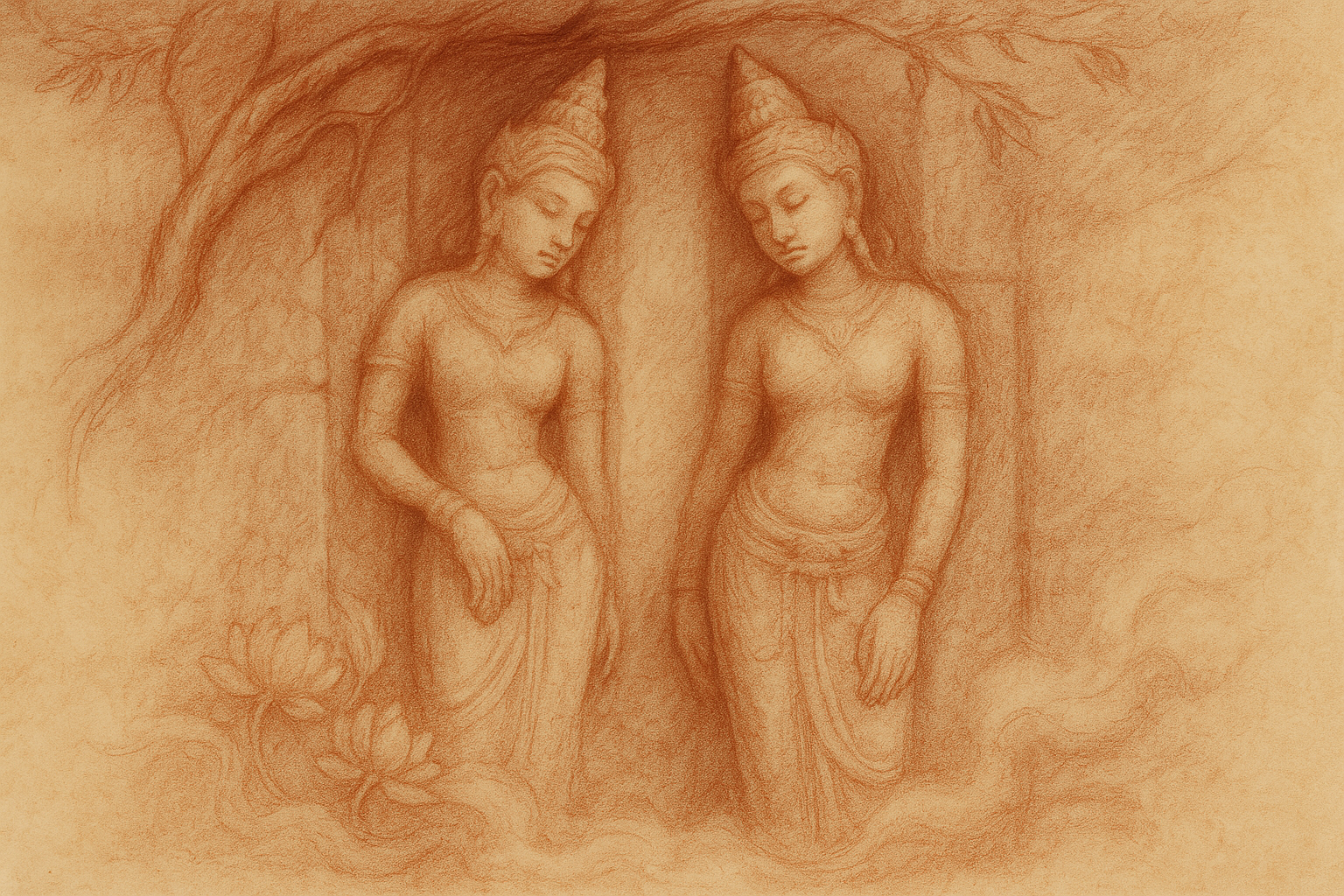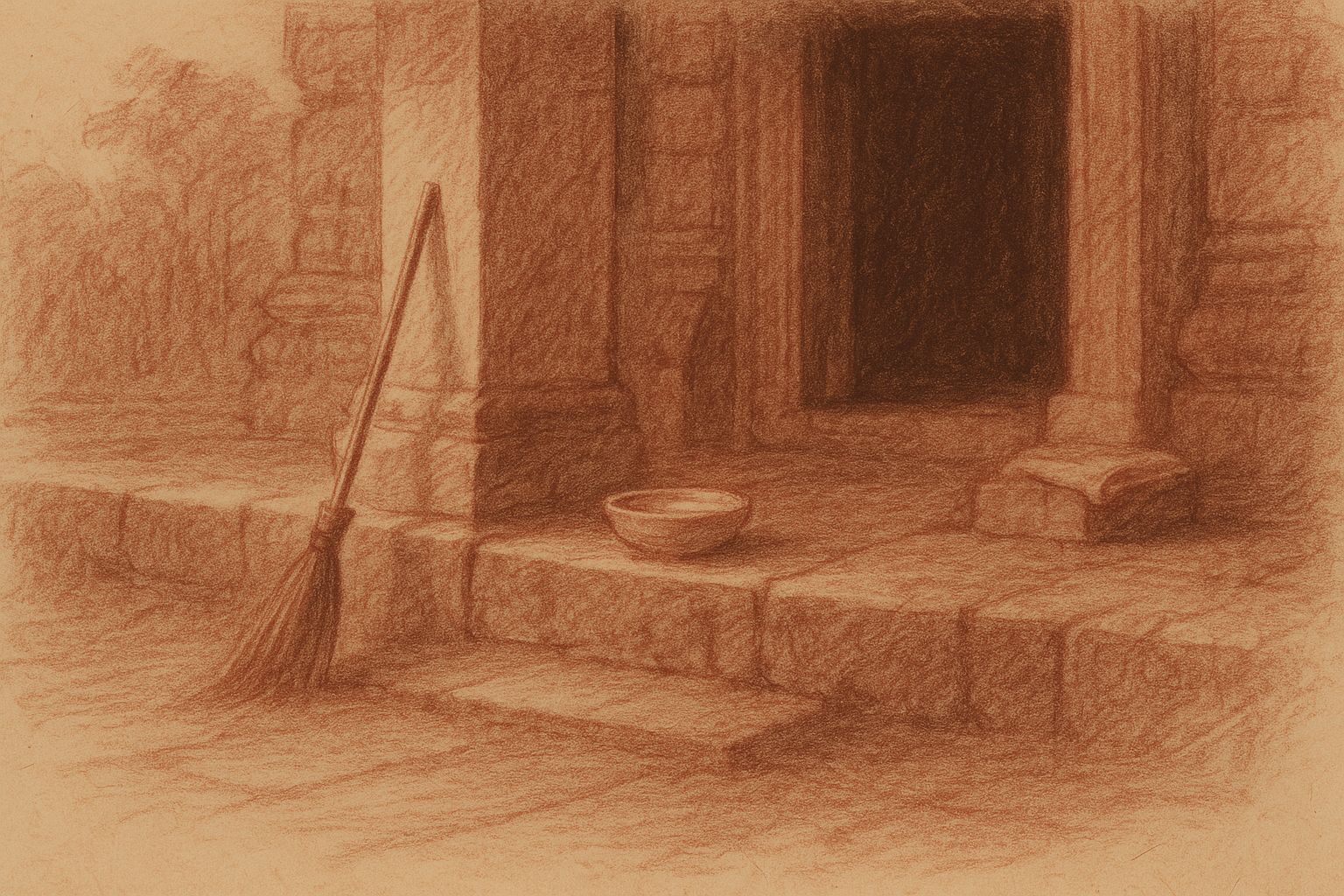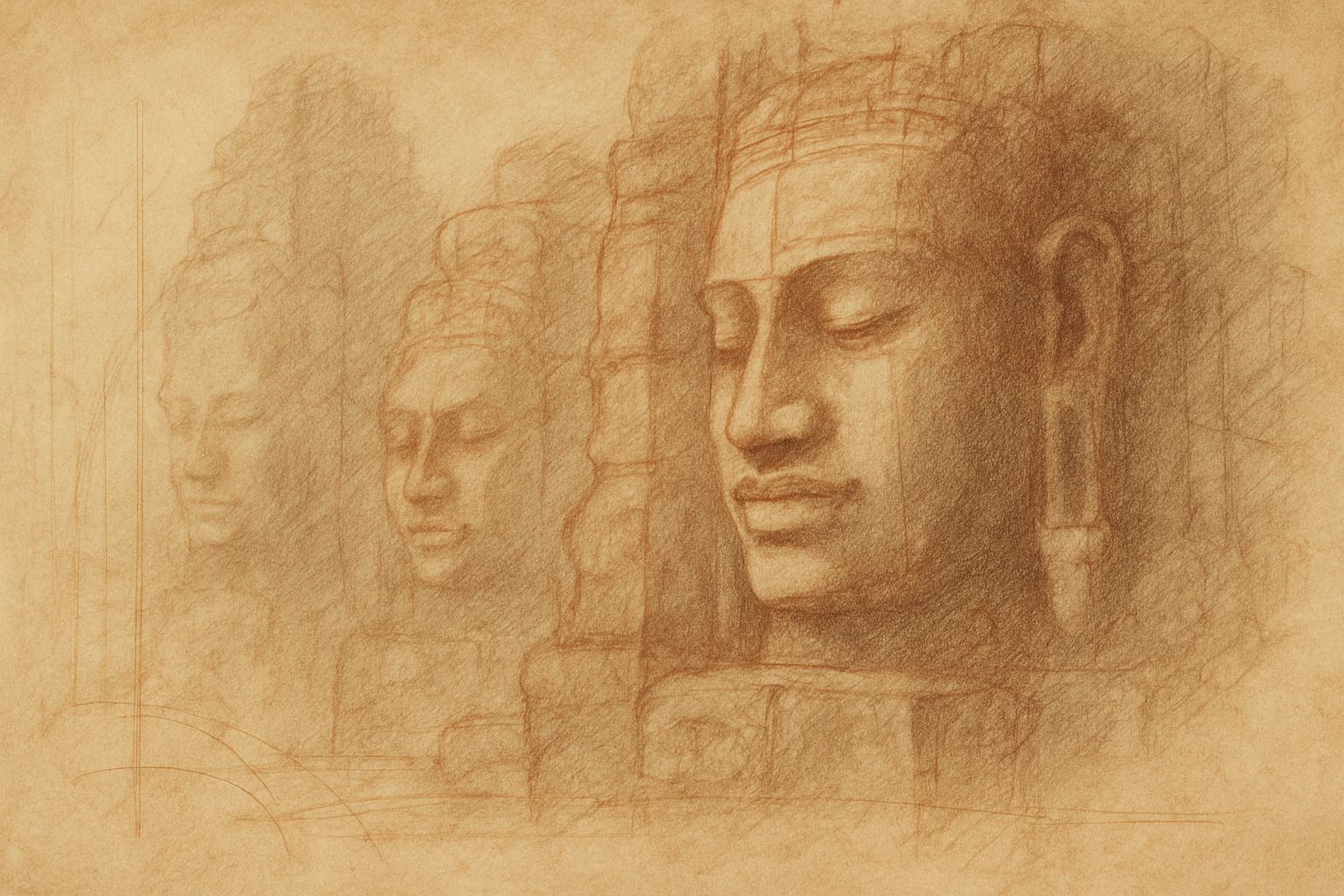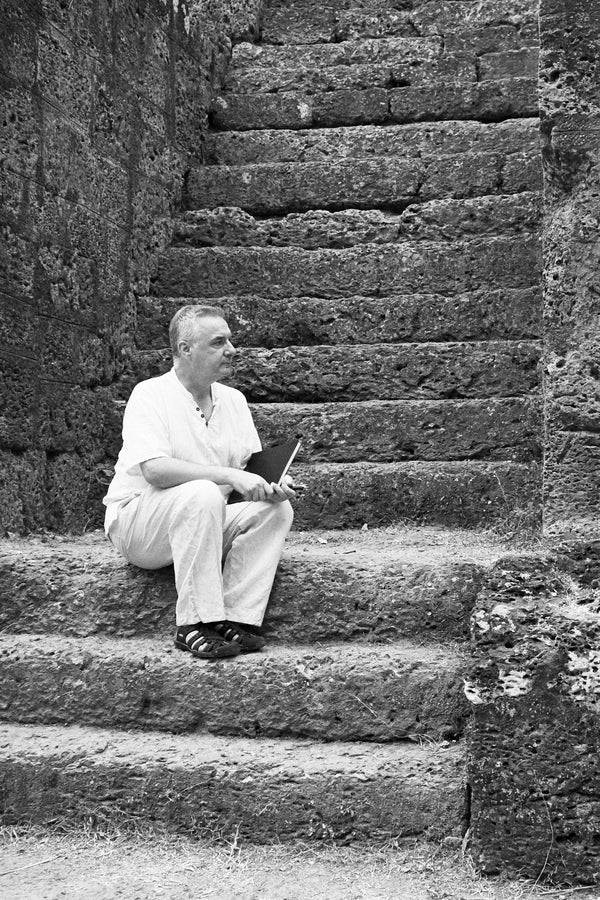Complimentary worldwide shipping on orders over $400 · No import tariffs for most countries
Complimentary worldwide shipping on orders over $400 · No import tariffs for most countries

The Lotus Sisters
From The Serpent and the Star – Khmer Myths from the Temples of Light and Shadow
In the hushed hours before dawn, the world between temple and forest holds its breath. Mist threads gently among the trees, tracing pathways older than memory. Moonlight—soft as mist, quiet as prayer—touches the stones carved by hands long turned to dust. And here, in a shadowed niche upon the wall, two apsaras stand side by side, their beauty shaped by devotion, their quietness spun from silence itself.
Villagers call them The Lotus Sisters. Yet their true names remain beyond recall, for the carvers left no mark, only the careful shaping of a single stone block into two forms—nearly identical, yet subtly not. One sister’s shoulder leans slightly toward the other, creating a delicate tilt as if yearning toward union, completion. Their gaze holds neither judgement nor blessing, but opens like a vessel into a silence that listens deeply, quietly receiving all who pause before them.
No temple records their origin. No priest chants their praise. Yet those who seek them, those who journey along faint trails softened by moss and moonlight, feel something older than stone waiting in the hush between their still eyes. They kneel, reverent and wordless, and wonder at the tremor they sense in the silence—a gentle pulse, like the breath beneath sleeping waters.
Long ago, before these apsaras found their shape in stone, there lived twin sisters. Their beauty was not the sort celebrated in songs or painted upon royal walls. It was quieter, more subtle—like lotus buds rising from still pools, carrying within themselves the promise of unfolding. They spoke rarely, and when they did, their voices mirrored each other softly, like two notes suspended upon a single breath.
They lived at the temple’s edge, tending the lotus ponds and the shrines left behind by kings and forgotten by priests. At dawn, they would sit beneath the spreading branches of banyan trees, watching the rising mist erase boundaries between water and sky, between earth and memory. And in these liminal moments, they listened—to the faint music woven from wind and leaf, from silence and spirit, from things seen and unseen.
One morning, as the first fingers of light brushed the tips of the lotus petals, a traveller appeared—a sculptor with hands both weathered and graceful, who carried tools that had shaped sacred images in many kingdoms. He sought neither fame nor royal favour. Instead, he sought the quiet beauty that dwells at the edge of shadows, the truth that waits beneath the surface of stone.
He watched the sisters move about their work, observed how one would lean toward the other as they knelt, how their silent exchanges formed invisible threads of presence between them. And in his heart, he saw clearly the image that awaited his carving—two apsaras born from a single stone, figures whose silence would not speak but would listen, whose gentle forms would guard an entrance that had no door.
He chose a place hidden by shadows, away from the temple’s central shrine. There he worked in solitude, shaping not only their forms but also their silence. Each strike of his chisel was a prayer; each caress of his hand was devotion made manifest. Day and night blurred in quiet labour. His heart became a vessel of reverence, his body the medium through which stone yielded gently into grace.

When at last the carving was complete, villagers came to marvel at what had appeared overnight. They saw the twin apsaras, adorned by lotus petals curling tenderly around wrists and ankles, their gaze steady, serene. But it was the subtle difference that drew them close—the slight inclination of one toward the other, the soft emptiness between their eyes. Those who paused felt an invisible door open within themselves, as if a whisper had touched their spirit—a soundless invitation into the stillness that listens back.
Time passed. The sculptor departed without a word, leaving behind only his tools, scattered softly beneath banyan roots like forgotten offerings. The living sisters grew older, their quiet devotion undiminished. And one evening, as twilight unfolded gently over the ponds, they sat beneath the banyan tree for the final time.
No one saw their leaving. But villagers who passed the pond at dawn felt a hush unlike any before. The lotus flowers, once closed tightly at night, were open and luminous before sunrise, and the mists lingered longer as if guarding a secret. Birds ceased their morning song until light fully reclaimed the sky, honouring the quiet that had descended.
From that day onward, something changed in the stone carving. Those who approached the Lotus Sisters felt a hum in the air, a stillness so profound it became presence. The sisters did not speak in dreams or visions, nor did they grant wishes or blessings. They simply listened, receiving each visitor with a silence that opened within them, mirroring their devotion and quiet yearning toward something unnamed, something sacred and utterly beyond words.
Yet, through generations, villagers returned to kneel before the carving, hearts stilled by the knowing gaze that never moved but always held them. Some lingered for hours, others only moments. But all departed changed—quietly, imperceptibly transformed—having been seen not by eyes of stone, but by the silent space between them.
And still, travellers come to the hidden niche in the temple wall, guided by whispers, half-forgotten directions, or an ache they cannot explain. They kneel, eyes closed or open, breathing in rhythm with the pulse that beats softly, eternally, between the two sisters carved from one stone. They feel the gentle lean of shoulder toward shoulder, the hush like lotus petals opening in twilight, and the quiet certainty that some truths are found only in silence.
And when they rise and turn away, their footprints blend gently into moss and dust, vanishing beneath moonlight. But between the two carved faces, a presence waits—a presence that has always waited—soft as breath, clear as water, luminous as dawn.
Also in Library

Those Who Keep the Way Open — On the Quiet Guardians of Angkor’s Thresholds
3 min read
Quiet gestures shape the way into Angkor — a swept stone, a refilled bowl, a hand steadying a guardian lion. This essay reflects on the unseen custodians whose daily care keeps the thresholds open, revealing how sacredness endures not through stone alone, but through those who tend its meaning.

Multiplicity and Mercy — The Face Towers of Jayavarman VII
5 min read
A new vision of kingship rises at the Bayon: serene faces turned to every horizon, shaping a world where authority is expressed as care. Moving through the terraces, one enters a field of steady, compassionate presence — a landscape where stone, light, and time teach through quiet attention.

Stone That Dreams
4 min read
Bayon wakes like a mind emerging from shadow. Its many faces shift with light and breath, teaching that perception—and the self—is never singular. In walking this forest of towers, the pilgrim discovers a quiet multiplicity within, held together by a calm that feels both ancient and newly understood.
Angkor Wat Temple, Angkor, Cambodia — 2020
Limited Edition Archival Pigment Print
Edition
Strictly limited to 25 prints + 2 Artist’s Proofs
Medium
Hand-toned black-and-white archival pigment print on Hahnemühle Bamboo — a museum-grade fine art paper chosen for its quiet tactility and reverent depth, echoing the spirit of the temples.
Signature & Numbering
Each print is individually signed and numbered by the artist on the border (recto)
Certificate of Authenticity
Accompanies every print
Image Size
9.5 x 6.8 inches (24.1 x 17.3 cm)
There are devatas who guard, and devatas who guide—but these two, carved in gold-shadowed stone at the courtyard of Angkor Wat’s second floor, do something rarer still: they smile. And what passes between them is not silence, but sisterhood.
The sandstone wall from which they emerge was left unfinished, and perhaps because of this, their presence feels even more alive—two figures poised mid-laughter, lotus blossoms resting across their shoulders like garlands passed between gods. They are nearly identical, yet subtly distinct, and in that tension blooms a sacred mischief.
Captured by Lucas Varro on large-format black-and-white film in the golden hush of evening, the image was shaped with classical chiaroscuro and later hand-toned in gold. This final gesture—the gold—was not for show, but for remembrance: a way to honour what the light had once touched, and what it now leaves behind.
Printed on museum-grade Hahnemühle Bamboo paper, each impression is hand-toned, signed, and presented in a strictly Limited Edition of 25 + 2 Artist’s Proofs. These are not multiples, but meditations.
To live with this image is to welcome the hush of joy into your home.
Click here to follow their whispered laughter into the Artist’s Journal.
Join My Studio Journal
Receive occasional letters from my studio in Siem Reap—offering a glimpse into my creative process, early access to new fine art prints, field notes from the temples of Angkor, exhibition announcements, and reflections on beauty, impermanence, and the spirit of place.
No noise. No clutter. Just quiet inspiration, delivered gently.
Subscribe and stay connected to the unfolding story.

Join My Studio Journal
Receive occasional letters from my studio in Siem Reap—offering a glimpse into my creative process, early access to new fine art prints, field notes from the temples of Angkor, exhibition announcements, and reflections on beauty, impermanence, and the spirit of place.
No noise. No clutter. Just quiet inspiration, delivered gently.
Subscribe and stay connected to the unfolding story.

